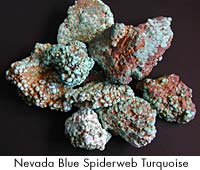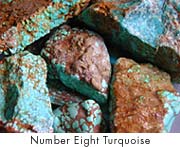 NEVADA BLUE
NEVADA BLUE
 Nevada
Blue belongs with the finest turquoise to come
out of Nevada. Once known as the Pinto or Watts
mine, the Nevada Blue is near the crest of the
Shoshone Range in Lander County, Nevada. The
deposit was discovered by Jim Watts in 1901
and later sold. Access to this mine is extremely
difficult. In its high-grade form the colors
range from a medium to a dark blue with a black
or brown spider webbing. Nevada
Blue belongs with the finest turquoise to come
out of Nevada. Once known as the Pinto or Watts
mine, the Nevada Blue is near the crest of the
Shoshone Range in Lander County, Nevada. The
deposit was discovered by Jim Watts in 1901
and later sold. Access to this mine is extremely
difficult. In its high-grade form the colors
range from a medium to a dark blue with a black
or brown spider webbing.
Nevada Blue turquoise was well marketed in the
1970’s and was used by many of the Southwest’s
greatest silversmiths. The April 1979 issue
of ‘Arizona Highways’ magazine will
attest to that fact with its pages filled with
Nevada Blue turquoise in museum quality jewelry.
 back to top
back to top
 NUMBER EIGHT
NUMBER EIGHT
 The
Number 8 turquoise mine is in the Lynn mining
district in Eureka County, Nevada. The mine
is considered depleted and has not produced
turquoise for a number of years, although much
is still available through collections and other
holdings. Earl Buffington and Lawrence Springer
filed the first formal claim on the property
in 1929. Not long after that time the mine began
going though a number of owners which included;
Ted Johnson, Doc Wilson, Myron Clark, Lee Hand,
the Edgar brother and Dowell Ward. All are important
names in Nevada’s turquoise mining history.
In 1950 the Edgars with a bulldozer began looking
for copper. What they did uncover was a deposit
of some of the finest spider web turquoise ever
found in Nevada. The pocket produced more than
1,600 pounds of the very highest-grade turquoise,
a discovery that is still being talked about
today. The
Number 8 turquoise mine is in the Lynn mining
district in Eureka County, Nevada. The mine
is considered depleted and has not produced
turquoise for a number of years, although much
is still available through collections and other
holdings. Earl Buffington and Lawrence Springer
filed the first formal claim on the property
in 1929. Not long after that time the mine began
going though a number of owners which included;
Ted Johnson, Doc Wilson, Myron Clark, Lee Hand,
the Edgar brother and Dowell Ward. All are important
names in Nevada’s turquoise mining history.
In 1950 the Edgars with a bulldozer began looking
for copper. What they did uncover was a deposit
of some of the finest spider web turquoise ever
found in Nevada. The pocket produced more than
1,600 pounds of the very highest-grade turquoise,
a discovery that is still being talked about
today.
 The
color of Number 8 varies from light blue, blue
with shades of green to beautiful dark blue.
It is found with a black, golden, red or brown
matrix. With the black and red spider webbing
being the most valued. Besides its beautiful
turquoise, Number 8 has also been known for
the large nuggets the mine produced. One nodule
of high-grade turquoise that was sold to C.G.
Wallace weighed more than nine pounds. Another
uncovered was one of the largest turquoise nodules
ever found. On June 23, 1954, T.G. Edgar, J.M.
Edgar and Marvin Symes discovered a specimen
that weighed 150 pounds. It was of good color
and hardness and classified as gem quality. The
color of Number 8 varies from light blue, blue
with shades of green to beautiful dark blue.
It is found with a black, golden, red or brown
matrix. With the black and red spider webbing
being the most valued. Besides its beautiful
turquoise, Number 8 has also been known for
the large nuggets the mine produced. One nodule
of high-grade turquoise that was sold to C.G.
Wallace weighed more than nine pounds. Another
uncovered was one of the largest turquoise nodules
ever found. On June 23, 1954, T.G. Edgar, J.M.
Edgar and Marvin Symes discovered a specimen
that weighed 150 pounds. It was of good color
and hardness and classified as gem quality.
Today Number 8 turquoise is one of the most
valuable stones that can be collected and one
of the most beautiful that can be used in jewelry.
High-grade Number 8 turquoise is by far some
of the finest turquoise to ever have come out
of Nevada.
 back to top
back to top
 ORVIL JACK see
BLUE RIDGE
MINE page
ORVIL JACK see
BLUE RIDGE
MINE page
 PERSIAN
PERSIAN
Little needs to be said about Persian turquoise,
as it was long considered the finest turquoise
in the world. It has always been the gold standard
of quality. The beautiful blue color of Persian
and its rarity in today’s market makes
this wonderful turquoise highly valued. Mines
in the northern areas of Iran have been producing
turquoise for many centuries. For over 800 years
Persia (Iran) produced the bulk of the world’s
turquoise using the simplest of hand tools made
from stone then later with picks and crowbars.
The oldest continuously operated mines known
were operated in the Ali-Mursa-Kuh Mountains
near Nishapur, Khorasan, Iran. They were known
to have operated at least since 1000 AD and
it is possible since 2100 BC.
The rich blue color of the turquoise has always
been prized and produces superb cabs in its
flawless form. Many feel that when Persian turquoise
is found in its matrix form with the fine colors
of the limonite that it is just as beautiful.
|